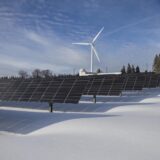
Japan unveils ambitious new renewable energy targets
Japan unveiled a draft of its new Basic Energy Plan last week, which aims to increase its reliance on renewable energy to nearly 40% by 2030. The plan will be finalized next month and will be presented for public comment. The Cabinet has to approve the plan, after which it will be presented to the U.N. COP26 meeting in Glasgow, Scotland, in late October.
The Japanese government updates its energy plan every few years. The revision of the Basic Energy Plan is a pivotal point to demonstrate Japan’s political will to achieve net zero by 2050. In 2019, Japan’s energy mix consisted of clean energy at 18%, fossil fuels at 76%, and nuclear power at 6%.
The industry ministry’s policy draft aims for renewables to account for 36-38% of the electricity mix in 2030, double the level of 18% in the financial year to March 2020. The earlier target was for renewables to contribute 22-24% of electricity in 2030.
Fossil fuel use is to be reduced from 56% to 41% by 2030. Coal consumption will be reduced to 19% from 26% under the new plan. Liquefied natural gas (LNG) will make up most of the rest of the fossil fuel portion of the target energy mix.
Japan aims to reduce its reliance on nuclear power as much as possible while it boosts renewable power capacity, but nuclear power will remain as an important base-load power source, the draft says. Its target for nuclear energy was left unchanged at 20-22%. Following the Fukushima disaster in 2011, all of the country’s nuclear reactors were shut down. Nine reactors are now operating from 54 previously. The draft did not include plans to build new nuclear plants.
Doubling solar power by 2030 could present its biggest challenge, due to Japan’s geography. Japan’s installed solar capacity per square kilometer on flat land is already the highest in the world, and the total installed capacity in Japan is the third highest. Since only about 30% of land in Japan is flat, expanding solar’s installed capacity will be a challenge.
With regards to offshore wind power, Japan is targeting 10 gigawatts (GW) of offshore wind farms by 2030, and 30 to 45 GW by fiscal 2040. Since Japan’s archipelago is surrounded by an ocean, floating wind turbines, instead of fixed-bottom wind turbines, would be more optimal, but double the cost.
New fuels like hydrogen and ammonia will account for about 1% of the electricity mix in 2030.
If achieved, the total carbon dioxide emissions from the consumption of fossil fuels and power generation, which currently represent approximately 90% of Japan’s total energy mix, would fall by about a third from 2019 levels to about 680 million tons in 2030.
.jpg)











